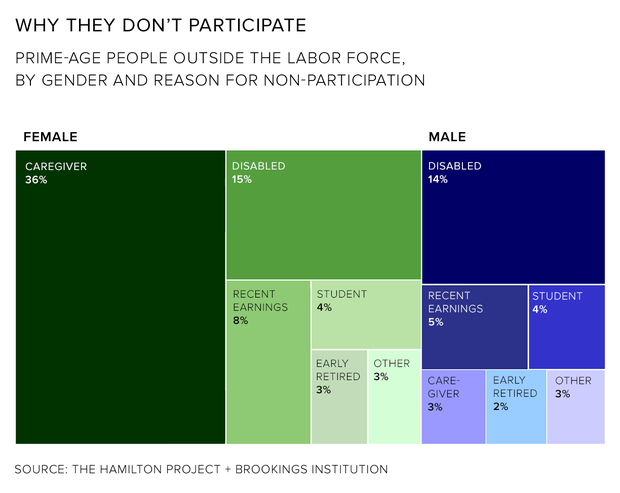Unemployment is down, but millions of Americans remain on sidelines
As Labor Day approaches, the U.S. unemployment rate looks like something to celebrate, leveling off to a 16-year low rate in May. Yet the number of adults of prime working-age who aren't actively looking for a job remains at the highest levels since the late 1990s, a trend economists find troubling.
So who are they, and why are they staying away?
Women staying home to take care of kids or an aging parent are the biggest group, a new analysis of 2016 labor data by the Hamilton Project shows. In total, about 24 million people, or 19 percent of Americans aged 25 to 54, didn't actively seek a job last year, according to the analysis of Federal Reserve data.
That's up from 16 percent in 2000 and 17 percent in November 2007, before the financial crisis and recession set in, according to the Hamilton report.
Of those, about 16 million women of prime working age didn't search for work, roughly twice the number of men. And women made up 36 percent of prime-age workers staying home as a caretaker, down from 39 percent a decade ago, a fairly steady rate, the analysis shows.
About 3 percent of men opting out of the workforce listed caregiving as a reason last year, an increase from 2 percent in 2006, according to the analysis.
Child care costs likely play a role in the persistent phenomenon, a 2014 Pew Research study showed. Whether by choice or necessity, millions of Americans continuing to sit on the economic sidelines may show a need for policy changes, said Hamilton Project Director Jay Shambaugh.
"Child care highlights that there is something holding back some that could participate," he said. It's "certainly going to leave you with disparities."
Once caregivers are excluded, men and women of prime working age have similar reasons, and similar rates, for staying out, the study shows. In about equal numbers by gender, people list being a student, early retirement or reliance on recent earnings as reasons for opting out of the labor force.
One striking figure: 11 percent reported using a government safety-net program to stay afloat, instead of looking to other sources, or people, for daily expenses.
"In some cases it's a spouse, in some cases it's a parent" providing income, Shambaugh said. "But the idea that people aren't in the labor force because they're sitting in the comfortable hammock of the safety net really doesn't seem to be an accurate picture of the people who are out of the labor force."
Disabilities keep about the same number of prime-age working people out of the workforce last year as a decade ago, about half men, half women.
Last year about 29 percent of working-age adults -- 15 percent of women and 14 percent of men -- reported being unable to work because of a disability, up just 1 percent from 2006. The stability in that figure is surprising, Shambaugh said.
"The increase in people out of the workforce is not simply a function of more people being disabled," Shambaugh said. "To me, it ran parallel to the number that the primary reason for people staying out of the workforce isn't to take advantage of the social safety net."
More than 1.3 million Americans who are out of the labor force report having no income at all, including lack of wages or unearned income, like retirement money or government payments. They're also living in different places: More women are living with spouses or partners, while more men are living with a parent, according to the Hamilton Project, a think tank focused on broadening economic prosperity.
Non-participants in the labor force, as economists call the group, are also poor: 45 percent of households, or 3.3 million, or with a man of prime working age and 28 percent or 4.6 million, of households with women of working age, are in the bottom fifth of income levels.
Education also plays a role. Women with a high school education or less were "overwhelmingly" the largest group not participating in the workforce at about 8 million, or about two women for every man.
Workers who have stopped looking for a job aren't counted as part of the nation's labor force participation rate, which includes people who are employed and those actively seeking work. That rate, a standard measure of the labor market's health, was 62.9 percent in July, down from 66 percent in July of 2007, just before the financial crisis.
The July non-participation rate for for 25-to-54-year olds was slightly lower than 2016 as a whole at 18 percent, the Hamilton report noted.




